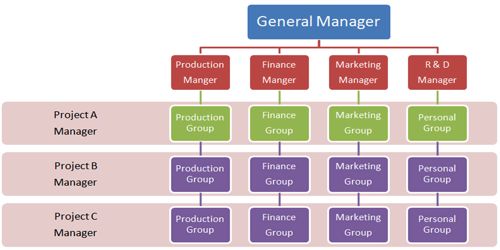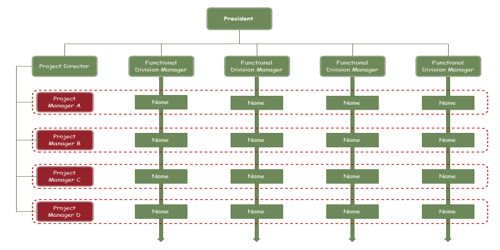Matrix Organization System of Project Organization
Large or small, every organization should operate with a defined organizational structure. A well thought out and strategic business configuration clarifies reporting relationships and supports good communication resulting in efficient and effective work process flow.
Matrix organization system: It refers to the combination of both functional and pure organizational system. A matrix structure provides for reporting levels both horizontally as well as vertically. For example, a recording engineer who works for a music publisher may have engineers who report to him but may also use his expertise and work with teams to develop new music albums.

Matrix organizations can be following three types:
(i) Week/Functional Matrix: A project manager with limited authority is assigned to oversee cross-functional aspects of the project. Functional managers maintain control over their resources and project areas.
(ii) Balanced functional Matrix: A project manager is assigned to oversee the project. Power is shared equally between the project manager and functional managers, combining the best aspects of functional and project-oriented organizations. This system is the most difficult to maintain because of difficulties in power-sharing.
(iii) Strong/Project matrix: A project manager is primarily responsible for the project. Functional managers provide technical expertise and assign resources as needed.
Advantages:
- Communication between functional divisions is enhanced.
- A project manager is held responsible for the successful completion of the project.
- Resources can be used efficiently since experts and equipment can be shared across projects.
- Duplication of resources is minimized.
- Team members have a functional “home” after project completion, so they are less worried about life-after-project than if they were a pure project organization.
- Policies of the parent organization are followed.
- Products and projects are formally coordinated across functional departments.
- Information flows both across and up through the organization.
Disadvantages
- There are two bosses. Hence, who can promote you or give you arise?
- It is doomed to failure unless the pm has strong negotiating skills.
- Sub-optimization is a danger, as PMs Hoard resources for their own project, thus harming other projects.















